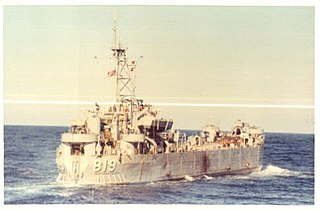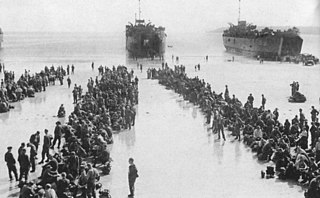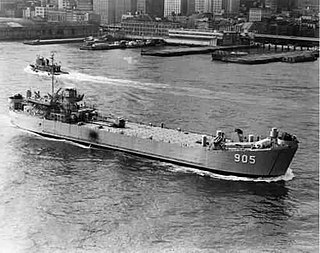
USS Orleck (DD-886), is a Gearing-class destroyer that was in service with the United States Navy from 1945 to 1982. In October 1982 she was sold to Turkey and renamed Yücetepe. After her final decommissioning the Turkish government transferred Yücetepe to the Southeast Texas War Memorial and Heritage Foundation at Orange, Texas, where she was berthed as a museum ship. The Orleck Foundation then decided to move the ship to the Calcasieu River in Lake Charles, Louisiana. On 26 March 2022, she arrived in Jacksonville, FL, where she served as a Naval Museum on the downtown riverfront until 3 April 2023, when she docked to its permanent home at the Shipyards West.

A landing ship, tank, (LST) is a ship first developed during World War II (1939–1945) to support amphibious operations by carrying tanks, vehicles, cargo, and landing troops directly onto a low-slope beach with no docks or piers. The shallow draft and bow doors and ramps enabled amphibious assaults on almost any beach.

USS Burnett County (LST-512) was an LST-491-class tank landing ship built for the United States Navy during World War II. Named for Burnett County, Wisconsin, she was the only U.S. Naval vessel to bear the name.

USS Hampshire County (LST-819) was an LST-542-class tank landing ship built for the United States Navy during World War II. Named for counties in Massachusetts and West Virginia, she was the only U.S. Naval vessel to bear the name.

USS LST-519 was an LST-491-class tank landing ship built for the U.S. Navy in World War II. She was later renamed USS Calhoun County (LST-519) after counties in eleven states in the United States.

USS LST–542 was the lead ship of her class of tank landing ships built for the United States Navy during World War II. She was later named USS Chelan County (LST-542) for the county in Washington, the only U.S. Naval vessel to bear the name. The LST-542-class was built with a water-distilling plant and heavier armament than the earlier LST-1 class, which slightly decreased their payload.

USS LST-209 was an LST-1-class tank landing ship built for the United States Navy during World War II. Like most of the ships of her class, she was not originally named, and known only by her designation. From June to August 1951 she served a stint as a part of the Military Sea Transportation Service (MSTS), crewed by civilians, and renamed USNS T-LST-209. She was recommissioned under her original name 24 August 1951, and renamed USS Bamberg County (LST-209) on 1 July 1955. She was named for Bamberg County, South Carolina, the only U.S. Naval vessel to bear the name.

USS Berkeley County (LST-279) was an LST-1-class tank landing ship built for the United States Navy during World War II. Named for counties in South Carolina and West Virginia, she was the only U.S. Naval vessel to bear the name.

USS LST-491 was the lead ship of her class of tank landing ships built for the United States Navy during World War II. Like many of her class, she was not named and is properly referred to by her hull designation.

USS LST-504 was an LST-491-class tank landing ship built for the United States Navy during World War II. Renamed USS Buchanan County (LST-504) for counties in Iowa, Missouri, and Virginia on 1 July 1955, she was the only U.S. Naval vessel to bear the name.

USS Cassia County (LST-527) was an LST-491-class tank landing ship built for the United States Navy during World War II. Named for Cassia County, Idaho, she was the only U.S. Naval vessel to bear the name. USS Cassia County is recognized for service in World War II during the Invasion of Normandy, and in the Korean War.

USS Chase County (LST-532) was an LST-491-class tank landing ship built for the United States Navy during World War II. Named after counties in Kansas and Nebraska, she was the only U.S. Naval vessel to bear the name.

USS Middlesex County (LST-983) was an LST-542-class tank landing ship built for the United States Navy during World War II. Named after counties in Connecticut, Massachusetts, New Jersey, and Virginia, she was the only United States Navy vessel to bear the name.

USS LST 393 is an LST-1-class tank landing ship built for the United States Navy during World War II. She is one of only two LSTs to survive in original configuration; 1,051 were built. She is now a museum ship in Muskegon, Michigan.

USS Hillsborough County (LST-827) was an LST-542-class tank landing ship built for the United States Navy during World War II. Named after Hillsborough County, Florida, she was the only U.S. Naval vessel to bear the name.

USS Madera County (LST-905) was a LST-542-class tank landing ship built for the United States Navy during World War II. Named after Madera County, California, she was the only U.S. Naval vessel to bear the name.

USS Orleans Parish (LST-1069) was an LST-542-class tank landing ship in the United States Navy during World War II. Unlike many of her class, which received only numbers and were disposed of after World War II, she survived long enough to be named. On 1 July 1955, all LSTs still in commission were named for US counties or parishes; LST-1069 was given the name Orleans Parish, after Orleans Parish, Louisiana. She was the only U.S. Naval vessel to bear that name.

USS LST-1074 was an LST-542-class tank landing ship built for the United States Navy during World War II. She was later named Overton County (LST-1074) for the Overton County, Tennessee—the only U.S. Naval vessel to bear the name—but never saw active service under that name.

USS LSM-45 was a LSM-1-class medium landing ship built for the United States Navy during World War II. The ship also served as Ypoploiarchos Grigoropoulos (L161) in the Hellenic Navy from 1958 to 1993. She was the last known surviving LSM in its original configuration. Her last location before scrapping was Marine Corps Base Camp Lejeune in North Carolina. LSM-45 was donated to the Museum of the Marine by the now defunct Amphibious Ship Museum under the understanding that it would be put on display at the museum, and was towed to North Carolina in 2004 from Omaha, Nebraska. The museum decided in 2007 that the ship would not be a part of the museum and tried looking for another home for the ship. In 2009, there were reports that the Museum was considering scrapping or sinking the ship as an artificial reef, and she was scrapped sometime between 2010 and 2014.

USS AFDM-2,, is an AFDM-3-class medium auxiliary floating drydock built in Mobile, Alabama by the Alabama Drydock and Shipbuilding Company for the U.S. Navy. Originally named USS YFD-4, Yard Floating Dock-4, she operated by Todd Shipyards at New Orleans, Louisiana for the repair of US ships during World War II. YFD-4 was renamed an Auxiliary Floating Dock Medium AFDM-2 in 1945 after the war.





































